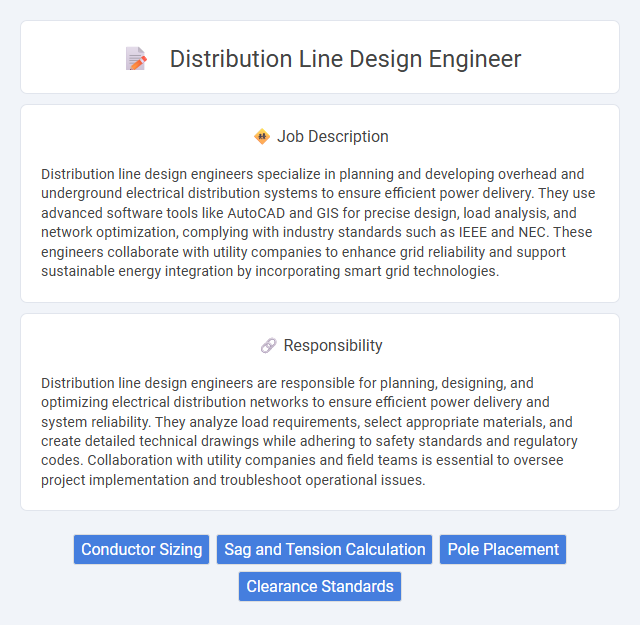
Distribution line design engineers specialize in planning and developing overhead and underground electrical distribution systems to ensure efficient power delivery. They use advanced software tools like AutoCAD and GIS for precise design, load analysis, and network optimization, complying with industry standards such as IEEE and NEC. These engineers collaborate with utility companies to enhance grid reliability and support sustainable energy integration by incorporating smart grid technologies.
Individuals with strong analytical skills and a keen interest in electrical systems will likely be well-suited for a Distribution Line Design Engineer role. Those comfortable working with technical software and able to manage field conditions or site visits may find the job aligns with their strengths. Candidates preferring structured problem-solving and collaborative teamwork probably have a higher chance of success in this position.
Qualification
A Distribution Line Design Engineer typically requires a Bachelor's degree in Electrical Engineering or a related field, with strong knowledge of power distribution systems and electrical codes. Proficiency in designing overhead and underground distribution lines using software tools such as AutoCAD and GIS is essential. Experience with load flow analysis, fault calculations, and compliance with industry standards like IEEE and National Electrical Safety Code (NESC) greatly enhances job performance.
Responsibility
Distribution line design engineers are responsible for planning, designing, and optimizing electrical distribution networks to ensure efficient power delivery and system reliability. They analyze load requirements, select appropriate materials, and create detailed technical drawings while adhering to safety standards and regulatory codes. Collaboration with utility companies and field teams is essential to oversee project implementation and troubleshoot operational issues.
Benefit
Distribution line design engineers likely enjoy benefits such as competitive salaries and opportunities for career growth within the energy sector. They may have access to professional development programs, enhancing their technical skills and industry knowledge. Employee benefits might also include health insurance, retirement plans, and work-life balance initiatives, contributing to overall job satisfaction.
Challenge
Distribution line design engineers likely face complex challenges related to optimizing energy efficiency while ensuring system reliability under varying environmental conditions. They probably encounter difficulties in balancing cost constraints with safety regulations and technological advancements. Managing unexpected site conditions and integrating renewable energy sources may further complicate their design responsibilities.
Career Advancement
A Distribution Line Design Engineer plays a critical role in planning and developing electrical distribution networks, utilizing advanced software and engineering principles to ensure efficient energy delivery. Mastery in load analysis, system reliability, and regulatory compliance enhances opportunities for promotion to senior engineering roles or project management positions. Continuous skill development in emerging smart grid technologies and standards significantly accelerates career growth within the power distribution industry.
Key Terms
Conductor Sizing
Distribution line design engineers specialize in conductor sizing to ensure optimal electrical load capacity and system reliability. They analyze current carrying capacity, voltage drop, and environmental factors such as temperature and wind to select appropriate conductor materials and sizes. Proper conductor sizing minimizes energy losses, enhances safety, and supports efficient power distribution.
Sag and Tension Calculation
Distribution line design engineers specialize in optimizing electrical power lines by conducting precise Sag and Tension Calculations to ensure structural integrity and safety under various environmental conditions. These calculations determine the appropriate conductor sag and tension values, accounting for factors such as span length, conductor weight, temperature variations, and wind loads. Mastery in using advanced software tools and adhering to industry standards like IEEE and NESC is essential for minimizing line losses and preventing mechanical failures.
Pole Placement
Distribution line design engineers specialize in optimizing pole placement to ensure efficient electrical distribution networks. They analyze terrain, load requirements, and regulatory standards to strategically position poles for enhanced stability and minimal environmental impact. Precision in pole placement reduces maintenance costs and improves service reliability across the power grid.
Clearance Standards
Distribution line design engineers ensure power lines comply with stringent clearance standards to maintain safety and reliability. These standards dictate minimum distances between electrical conductors, structures, and the ground to prevent electrical hazards and service interruptions. Expertise in local and national clearance codes, such as IEEE and NESC, is essential to optimize line layout and reduce risk of electrical faults.
 kuljobs.com
kuljobs.com